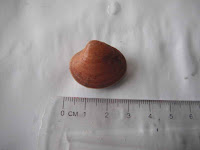This time it's good morning from the day shift! Having collected and sieved 157 Hamon grab samples from East of Gannet and Montrose Field NCMPA and 50 from Norwegian boundary Sediment Plain NCMPA we are getting very familiar with a few of the animals in the mud.
The grab collects about 25 litres of seabed sediments and deposits it in a large tray. This sediment is then sieved with running water to remove the finer sediment leaving behind shells, stones and any animals.
The sieves so far have contained an assortment of worms, clams, urchins, hermit crabs, brittlestars and sea pens. Among the empty shells present in the sediments, we are finding lots of tusk shells (Scaphopods), which are molluscs commonly found in the offshore muddy sediments but rarely seen along a beach. Large numbers of the empty bivalve shells have a small perfectly round hole through the shell. It is likely these have been eaten by predatory snails which bore through the shell to reach the animal inside.
Many of the grabs contain small brittle stars (see image below). These have five arms which, as their name suggests, are fragile and easily break off. This helps the brittle star escape from predators, and the brittle star is able to regrow the lost arm. They also use these arms for feeding, where they hold their arms up off the seabed in the water to collect passing food particles.
The Norwegian Boundary Sediment Plain NCMPA grab samples have been muddy sand and we have regularly found heart urchins, or sea potatoes as they are more commonly called. These bury into the sediment using their spines and feed on particles that fall to the seafloor. Today, one grab contained a large, fist-sized, purple heart urchin (Spatangus purpureus).
We are currently taking advantage of some good weather to do some video work, but are looking forward to getting back to the sieving soon.
By Karen and Beckie
The grab collects about 25 litres of seabed sediments and deposits it in a large tray. This sediment is then sieved with running water to remove the finer sediment leaving behind shells, stones and any animals.
Seabed sediments straight from the grab (left) and the animals, stones and shells that remain after sieving © JNCC, 2015.
The sieves so far have contained an assortment of worms, clams, urchins, hermit crabs, brittlestars and sea pens. Among the empty shells present in the sediments, we are finding lots of tusk shells (Scaphopods), which are molluscs commonly found in the offshore muddy sediments but rarely seen along a beach. Large numbers of the empty bivalve shells have a small perfectly round hole through the shell. It is likely these have been eaten by predatory snails which bore through the shell to reach the animal inside.
Bivalves, hermit crabs and tusk shells have all been sighted in grab samples © JNCC, 2015.
Many of the grabs contain small brittle stars (see image below). These have five arms which, as their name suggests, are fragile and easily break off. This helps the brittle star escape from predators, and the brittle star is able to regrow the lost arm. They also use these arms for feeding, where they hold their arms up off the seabed in the water to collect passing food particles.
Brittle star collected in a grab sample © JNCC, 2012.
The Norwegian Boundary Sediment Plain NCMPA grab samples have been muddy sand and we have regularly found heart urchins, or sea potatoes as they are more commonly called. These bury into the sediment using their spines and feed on particles that fall to the seafloor. Today, one grab contained a large, fist-sized, purple heart urchin (Spatangus purpureus).
Purple heart urchin (Spatangus purpureus) © JNCC, 2015.
We are currently taking advantage of some good weather to do some video work, but are looking forward to getting back to the sieving soon.
By Karen and Beckie















